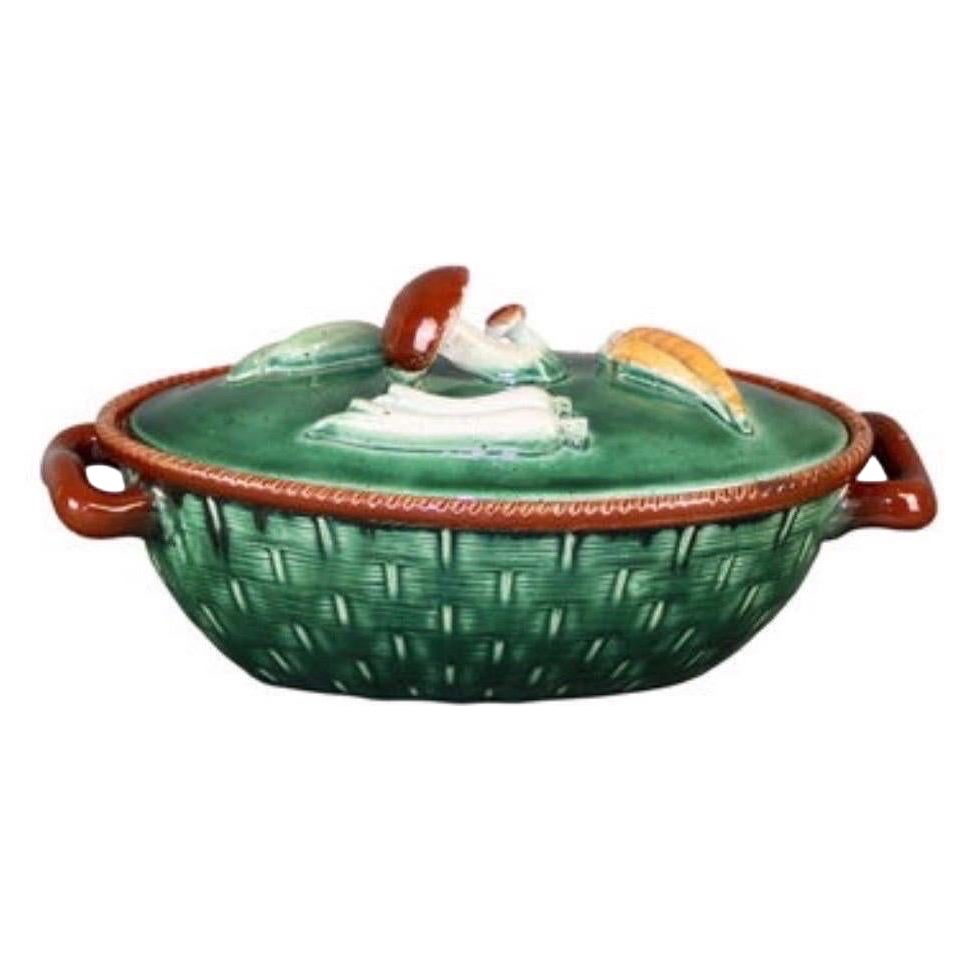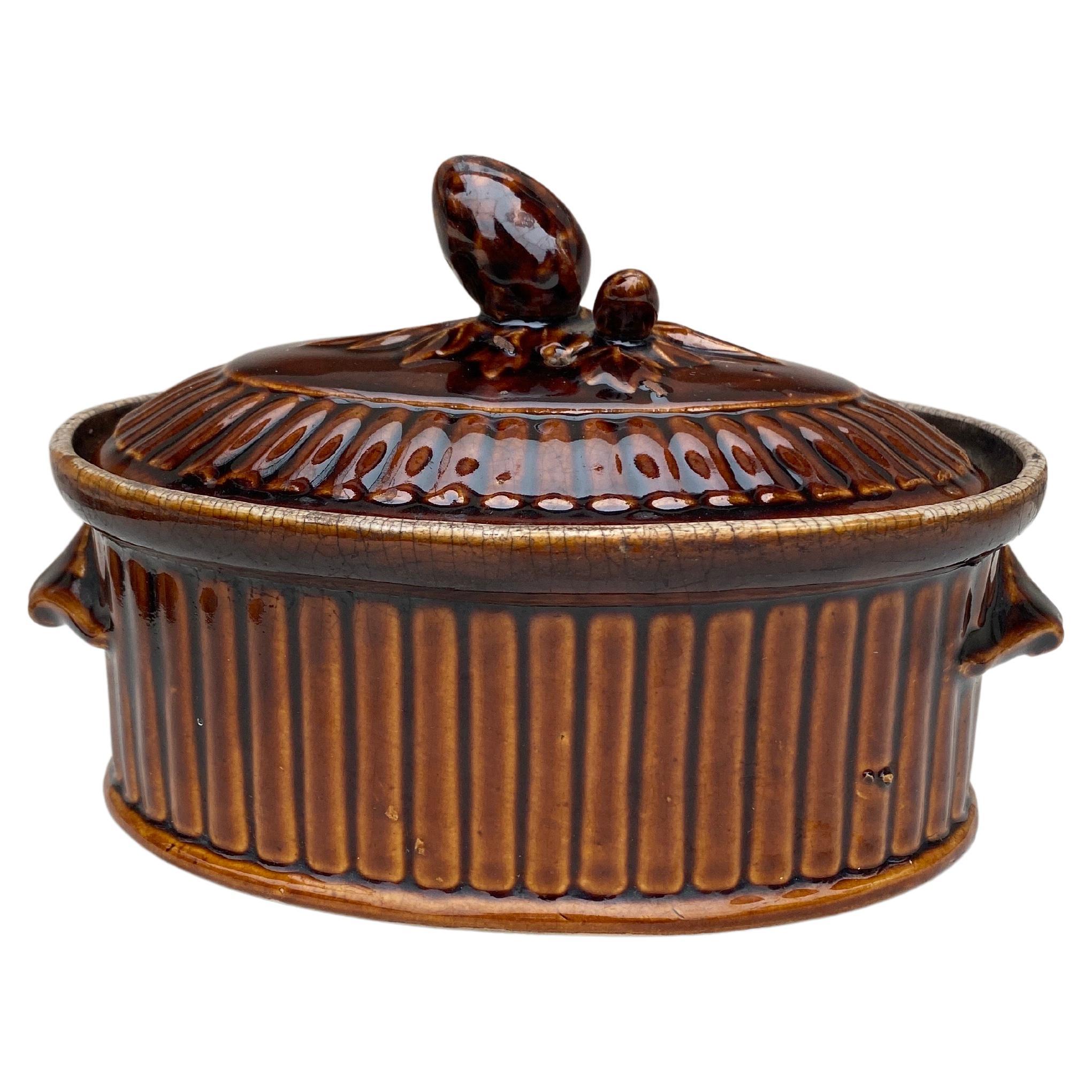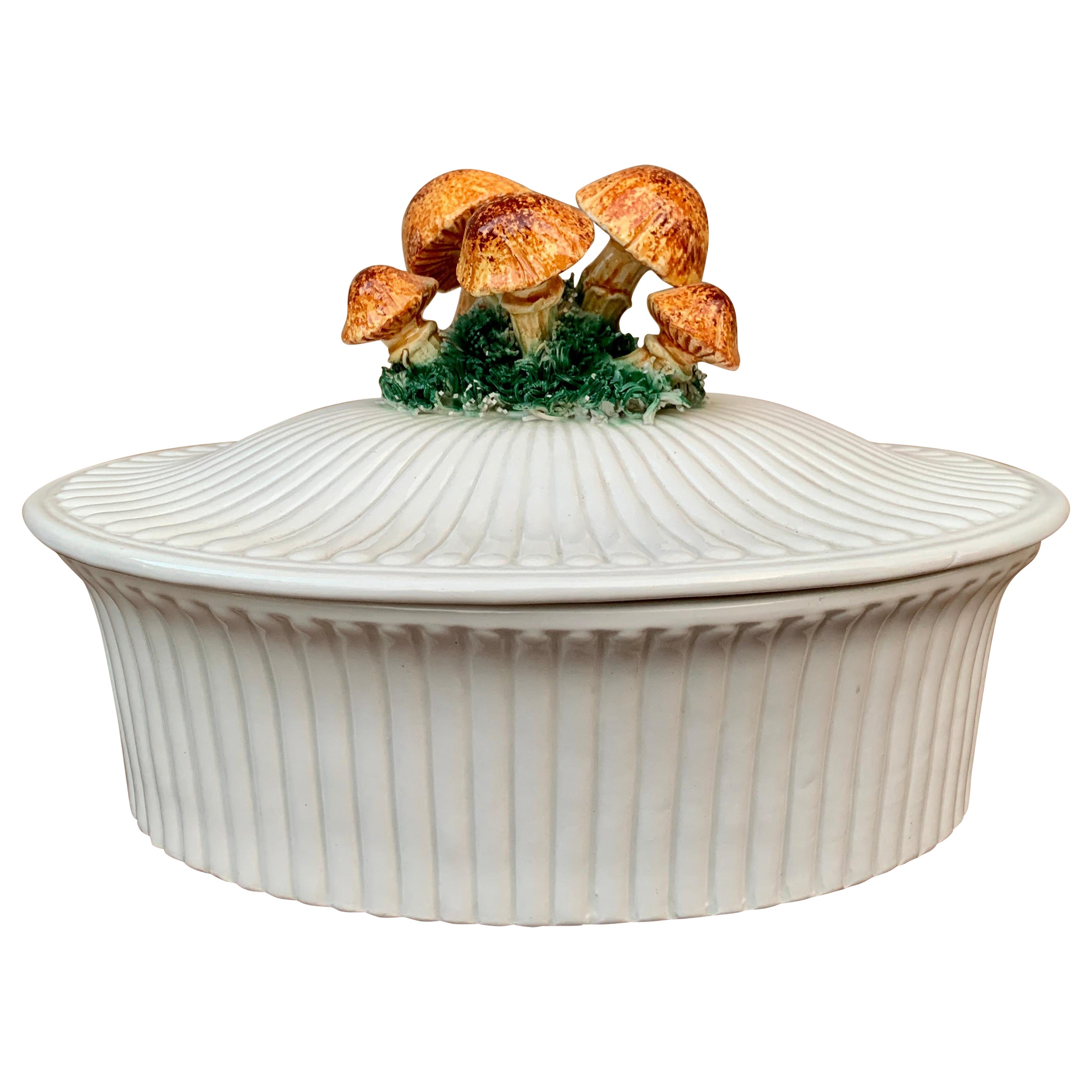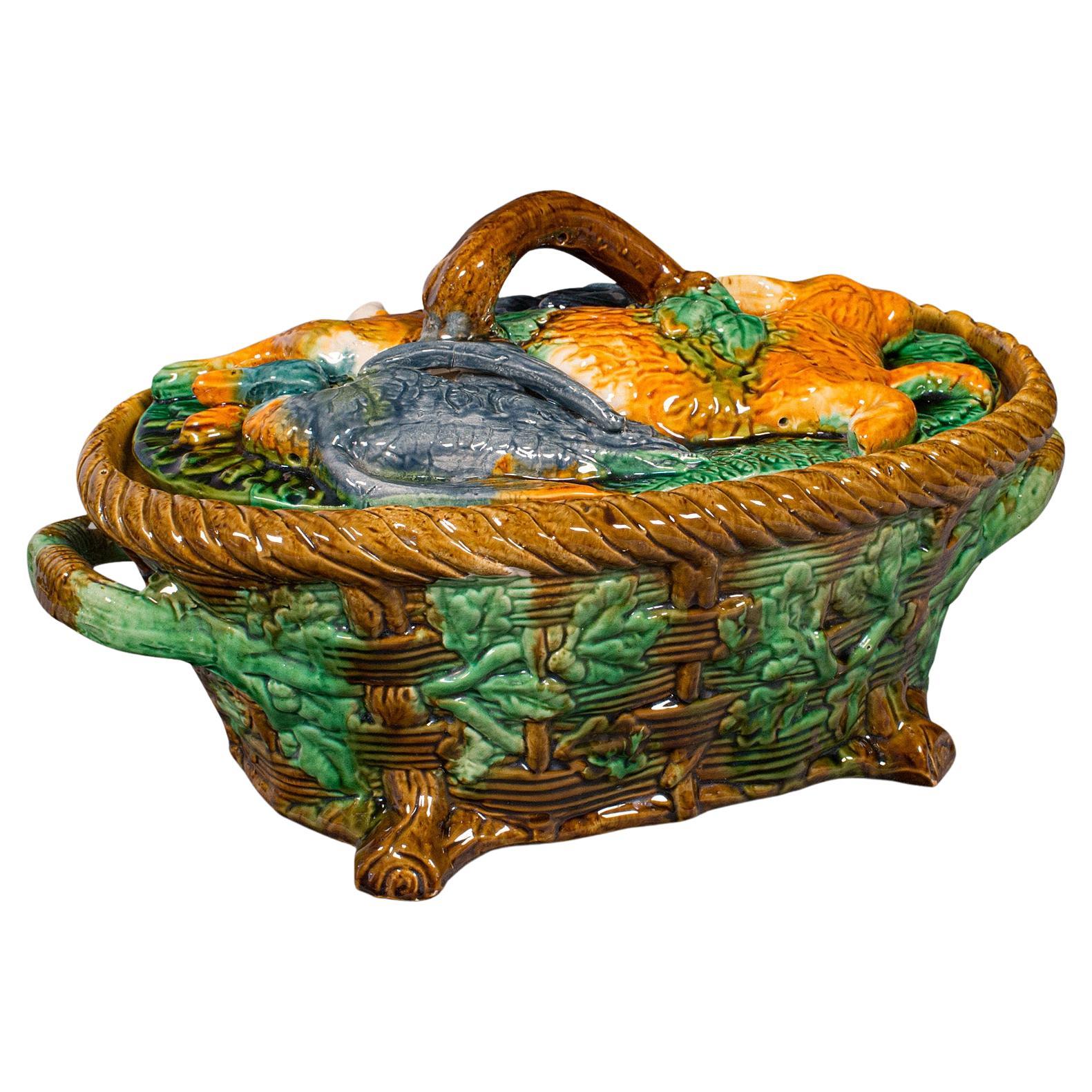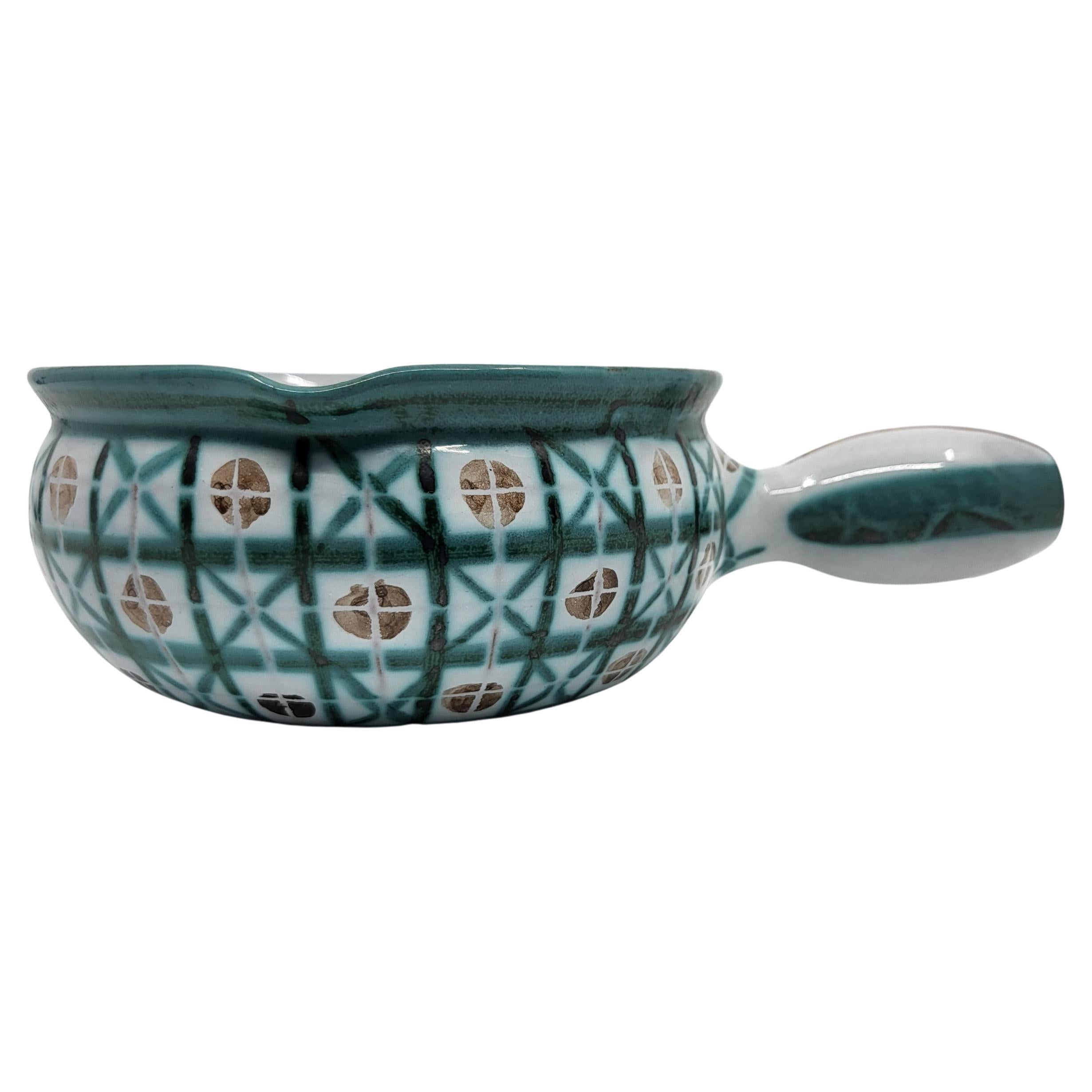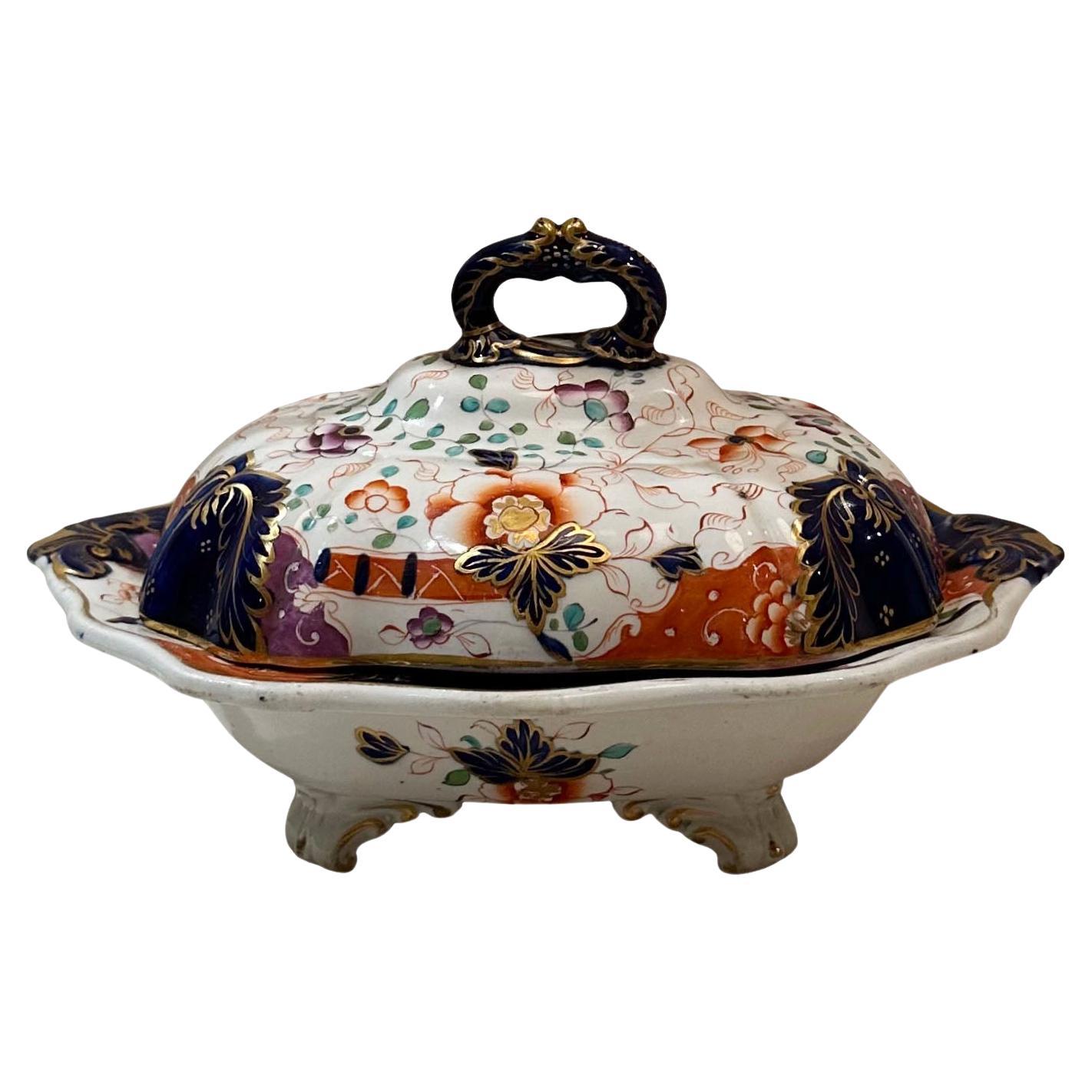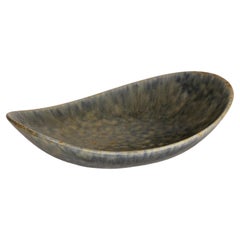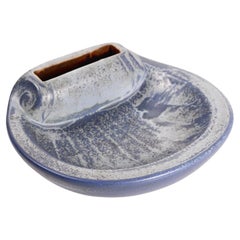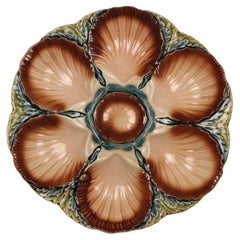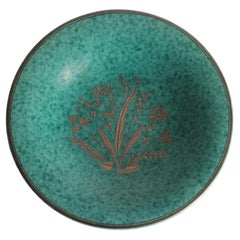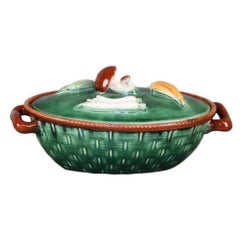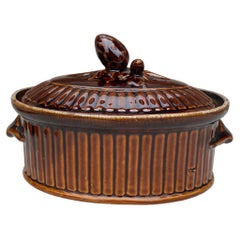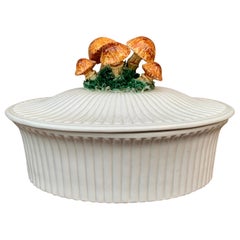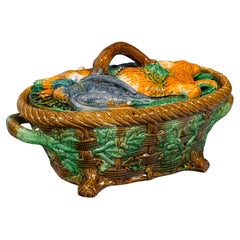Items Similar to 1930’s Belgium Ceramic Basket Casserole with Vegetable and Mushroom Lid
Want more images or videos?
Request additional images or videos from the seller
1 of 14
1930’s Belgium Ceramic Basket Casserole with Vegetable and Mushroom Lid
$209.56
£154
€180.92
CA$287.90
A$321.42
CHF 168.42
MX$3,934.46
NOK 2,138.90
SEK 2,016.72
DKK 1,350.26
About the Item
A wonderful Casserole bowl or dish with integral lid, produced in Belgium, circa 1930. A ‘Tellurite’ model number -1125- lidded tureen with basket weave sides in rich, deep earth tones of green around the body with brown basket weave handles. This piece’s personality stems primarily from the mushroom and vegetables decoration on the lid, springing forth like it was spored yesterday.
In good condition with no chips or cracks.
General note: Shipping quotes as supplied by 1stdibs are only indicative. We will discuss and figure out the best possible shipment method (and rate) for every individual object.
- Dimensions:Height: 7.09 in (18 cm)Width: 15.16 in (38.5 cm)Depth: 9.26 in (23.5 cm)
- Materials and Techniques:
- Place of Origin:
- Period:
- Date of Manufacture:1930s
- Condition:Wear consistent with age and use.
- Seller Location:London, GB
- Reference Number:1stDibs: LU2868327684952
About the Seller
5.0
Platinum Seller
Premium sellers with a 4.7+ rating and 24-hour response times
Established in 2015
1stDibs seller since 2017
194 sales on 1stDibs
Typical response time: 1 hour
- ShippingRetrieving quote...Shipping from: Maldon, United Kingdom
- Return Policy
Authenticity Guarantee
In the unlikely event there’s an issue with an item’s authenticity, contact us within 1 year for a full refund. DetailsMoney-Back Guarantee
If your item is not as described, is damaged in transit, or does not arrive, contact us within 7 days for a full refund. Details24-Hour Cancellation
You have a 24-hour grace period in which to reconsider your purchase, with no questions asked.Vetted Professional Sellers
Our world-class sellers must adhere to strict standards for service and quality, maintaining the integrity of our listings.Price-Match Guarantee
If you find that a seller listed the same item for a lower price elsewhere, we’ll match it.Trusted Global Delivery
Our best-in-class carrier network provides specialized shipping options worldwide, including custom delivery.More From This Seller
View AllScandinavian Modern Swedish Bowl by Carl Harry Stalhane and Maker Rorstrand
By Rörstrand, Carl-Harry Stålhane
Located in London, GB
Swedish ceramic artist Carl-Harry Stålhane (1920- 1990) played a major role in popularizing Swedish pottery during the 20th century, working for more than three decades at Rörstrand, one of the oldest ceramics manufacturers in Europe. During his long tenure at Rörstrand, Stålhane was responsible for small-batch studio pieces, mass-produced tableware , and all manner of decorative accessories .
Born in 1920 in Mariestad, Sweden, Stålhane began working at Rörstrand in 1939 as a decorative painter, assisting Danish-Finnish ceramic artist, designer, and sculptor Gunnar Nylund (1904-1997). During this time, Stålhane decorated various ceramic pieces, most notably Nylund’s Flambé range (1939s), quickly establishing himself as a talented ceramic artist. Inspired by the desire for new products during the postwar economic boom, Stålhane went from being a talented decorator to an exceptional ceramic artist.
In 1943, Stålhane caught the eye of Swedish artist Isaac Grünewald (1889-1946), who was visiting Rörstrand. Grünewald was so impressed with Stålhane’s work that he took him on as a student, and from 1943 to 1946, Stålhane studied art at Grünewald's Art School in Stockholm. Subsequently from 1947 until 1948, he studied sculpture at Académie Colarossi in Paris.
During the 1950s, Stålhane’s work appeared in several solo exhibitions in Sweden, the United Kingdom, and the United States. His Blanca Tableware range (c. 1955) won numerous international prizes and was in high-demand. In 1958, Stålhane succeeded Nylund as Artistic Director and Chief Designer at Rörstrand.
In 1960, Stålhane unveiled a new collection at Stockholm’s Galerie Blanche. Featuring dark stoneware pieces made from local clays, this collection represented a bold departure from the soft, restrained shapes of the 1950s. It has since been praised for its precient aesthetic that would influence the look of ceramics for more than a decade.
From 1963 until 1971, Stålhane taught ceramics at the Art Industrial School in Gothenburg. For a short time, he also was the Design Director at the Swedish factory Upsala Ekeby, which in addition to porcelain, produced tile, brick, and glass.
Stålhane eventually left Rörstrand in 1973 in order to establish his own ceramic company, Designhuset, in Lidköping, where he further experimented with local clays and minerals. Stålhane continued to work until his death in 1990. Today, Designhuset is a school for ceramists and model-makers.
Over the course of his career, Stålhane created several public works for The Commerce Trust Company in Kansas City, Missouri, and for Volvo in Gothenburg, Sweden. His work is represented at several international museums, including Stockholm’s Nationalmuseum and New York’s MoMA.
Rörstrand is the second oldest brand of ceramics in Europe and can be found in homes all across Sweden and Europe. Rörstrand’s long legacy includes some of Europe’s most iconic ceramics collections including Swedish Grace, Mon Amie, Ostindia, Filippa...
Category
Vintage 1950s Swedish Scandinavian Modern Ceramics
Materials
Ceramic, Stoneware, Pottery
Large Rörstrand Ashtray by Gunnar Nylund, 1950s Swedish Ceramic, Organic Form
By Rörstrand, Gunnar Nylund
Located in London, GB
Large Rörstrand Ashtray by Gunnar Nylund, 1950s Swedish Ceramic, Organic Form
A striking large ashtray, shell-like in its design, produced by the esteemed Swedish ceramic maker Rörs...
Category
Vintage 1950s Swedish Scandinavian Modern Ashtrays
Materials
Ceramic
19th Century Sarreguemines Majolica Seaweed and Shell Barbotine Oyster Plate
By Sarreguemines
Located in London, GB
Creating a wonderful display for Oysters or sea food this French Majolica oyster plate in lustrous deep colouring, but the well thought of maker Sarreguemines, circa 1890. Six scall...
Category
Antique 1890s French French Provincial Platters and Serveware
Materials
Ceramic, Earthenware
Art Deco Gustavsberg Argenta Ceramic Plate with Silver Inlay by Wilhelm Kåge
By Gustavberg, Wilhelm Kage
Located in London, GB
This wonderful Art Deco plate or shallow bowl made in Sweden 1930s at Gustavsberg factory, was designed by the painter and ceramicist Wilhelm Kåge. The name Argenta comes from the La...
Category
Vintage 1930s Swedish Art Deco Pottery
Materials
Silver
19th Century Sarreguemines Majolica Seaweed and Shell Barbotine Oyster Plate
By Sarreguemines
Located in London, GB
Creating a wonderful display for Oysters or sea food this French Majolica oyster plate in lustrous deep colouring, by the well thought of maker Sarreguemines, circa 1890. Six scallop...
Category
Antique 1890s French French Provincial Dinner Plates
Materials
Ceramic, Earthenware
A large English 19th Century Dairy Bowl from The Cotswolds
Located in London, GB
This wonderful over sized 19th Century Dairy Bowl was found in the darkest depths of The historic Cotswolds in England. A Hand made Dairy Bowl that we procured from a traditional che...
Category
Antique 1890s English Country Decorative Bowls
Materials
Pottery, Terracotta
You May Also Like
Vintage Belgium Majolica Ceramic Covered Game Dish Casserole - Mushroom Motif
Located in Atlanta, GA
Vintage Majolica lidded casserole tureen with raised vegetables.
Marked on bottom Belgium Tellurite Early 20th century.
6 1/2"h × 12" x 6 3/4"w
Adorned with Mushrooms, carrots an...
Category
Vintage 1930s Belgian Mid-Century Modern Centerpieces
Materials
Ceramic
French Pottery Majolica Tureen circa 1930
Located in Austin, TX
French Pottery Majolica Tureen circa 1930.
Category
Vintage 1930s French Rustic Serving Pieces
Materials
Ceramic, Faience, Majolica, Pottery
Vintage Italian Glazed Ceramic Trompe l'Oeil Mushroom Casserole Dish
Located in Elkhart, IN
A stunning and rare majolica ceramic trompe l'Oeil mushroom covered dish or casserole
Italy, Circa 1960s
Measures: 10.5"W x 7.5"D x 7"H
Very good original vintage condition. No ...
Category
Vintage 1960s Italian Country Serving Pieces
Materials
Ceramic, Paint
$1,196 Sale Price
20% Off
Vintage Game Pie Dish, English, Ceramic, Decorative, Pastry, Baking, Mid Century
Located in Hele, Devon, GB
This is a vintage game pie dish. An English, ceramic decorative pastry baking dish, dating to the mid 20th century, circa 1950.
Wonderfully distinctive with superb colour and deco...
Category
Mid-20th Century British Mid-Century Modern Decorative Dishes and Vide-P...
Materials
Ceramic
Casserole Robert Picault céramique Française Vallauris French Riviera 1960
By Robert Picault
Located in London, England
Robert PICAULT (1919-2000)
Céramiste de génie, ayant travaillé étroitement avec PICASSO et Roger CAPRON, il crée son propre ALQUIFOUX (mélange de de sulfure de plomb et de sable) et ...
Category
Vintage 1960s French French Provincial Ceramics
Materials
Ceramic
Davenport Covered Vegetable Tureen
Located in Tampa, FL
A Davenport ironstone covered vegetable tureen with lid in the Imari pattern. Early 19th century, England.
Category
Antique 1820s English Platters and Serveware
Materials
Ironstone
More Ways To Browse
Vintage Green Stemmed Glasses
Green Bowl With Handles
Vintage Glass Basket With Handle
Ceramic Mushroom
Silver Casserole
Silver Vegetable Dish
Green Bowl With Lid
Vegetable Tureen
Casserole Dish
Vintage Ceramic Mushrooms
Vintage Casserole Dish
Vintage Mushroom Pottery
Vintage Mushroom Bowl
French Mustard Pot
Studio Pottery Teapot
Plum Tree Pottery
Studio Art Pottery Charger
Antique Wine Glass Pottery And Glass
